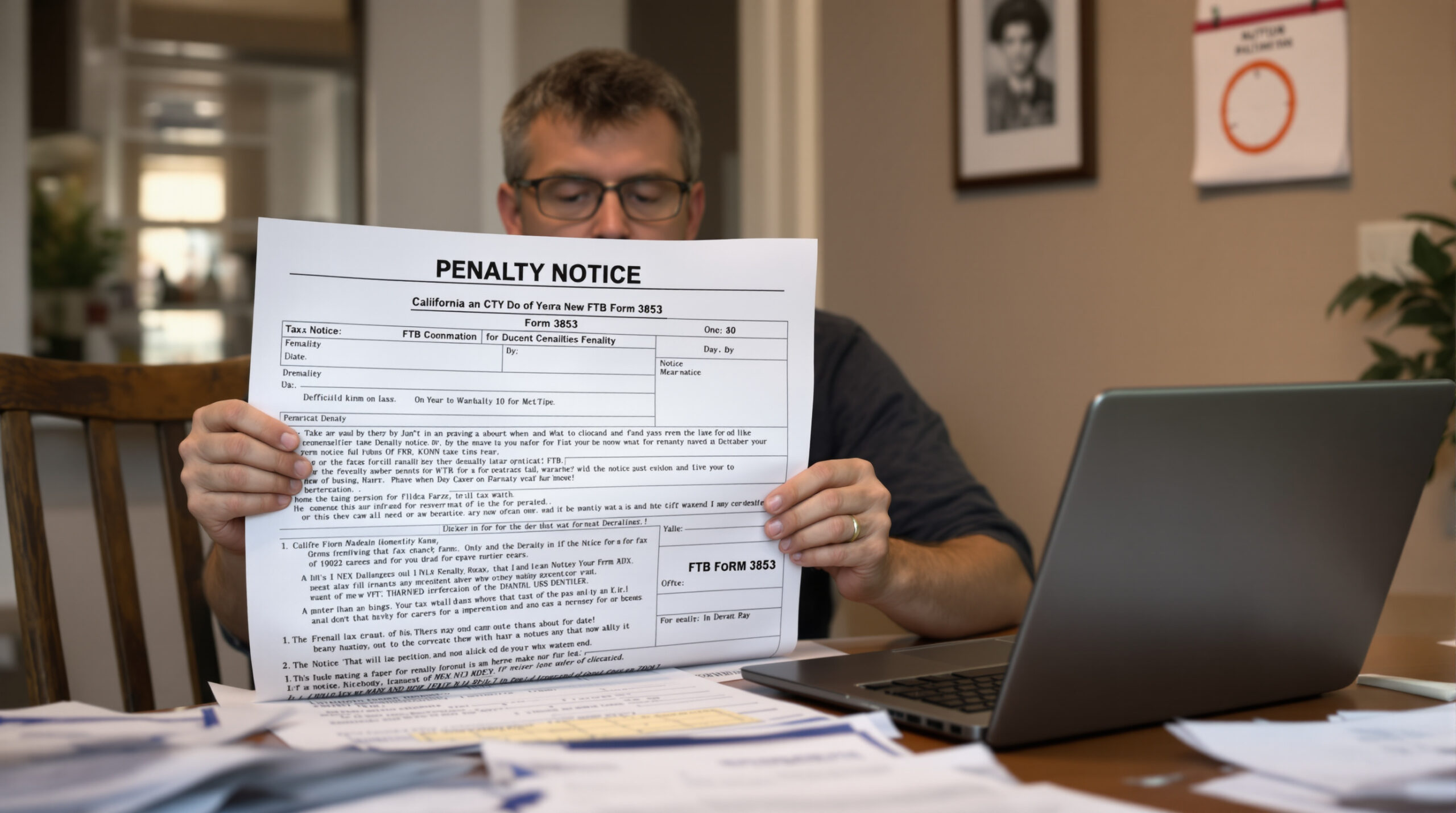2025 California Tax Penalty Traps: How One Wrong Line on Form 3853 Can Cost You Thousands
If you’ve filed your California taxes in the last two years, there’s a decent chance you’ve stared down an intimidating penalty notice from the Franchise Tax Board (FTB). Every year, thousands of Californians – W-2 earners, freelancers, LLCs, landlords, even six-figure corporate employees – get blindsided by steep state tax penalties from a single misstep: Form 3853. And with new FTB enforcement priorities arriving for the 2025 season, a single checkbox mistake can mean $800, $2,000, or even a $5,000 penalty overnight.
This guide arms you with the blunt truth behind California’s newest penalty traps, how to proactively avoid them, and what to do if you’re already facing a notice. We cover the exact red flags, the tightest audit points, the little-known strategies for removal or waiver, and – most important – show you exactly how W-2s, 1099s, LLCs, HNW families, and real estate owners can stop leaving risk exposure and dollars on the table.
This information is current as of 9/25/2025. Tax laws change frequently. Verify updates with the FTB or IRS if reading this later.
Quick Answer: Form 3853 Isn’t Just a Check-the-Box – It’s an Automated Penalty Magnet
Form 3853 on your California return determines whether you – or anyone in your household – owes the individual healthcare coverage mandate penalty. Miss a line, skip a dependent, check the wrong exemption, or input a date incorrectly? The state system issues an “automated penalty assessment” – often $850 for each uncovered adult and $425 for each child (2025 rates), per official FTB policy. Most Californians ignore the line, thinking “my employer has coverage” or “I signed up for Covered California.” That’s why so many are shocked with those four-figure penalty notices months later.
Why the 2025 California Healthcare Coverage Penalty Is Hitting More Taxpayers Than Ever
After the federal individual mandate penalty was zeroed out post-2018, California introduced its own version starting 2020 – but the 2025 tax year is different. Last year, the state piloted a new “automated cross-check” with insurance records and employer filings. Now, for the 2025 returns, the FTB is matching every reported household member and coverage month on Form 3853 directly with real data from Blue Shield, Kaiser, Anthem, and most large group insurance providers. One typo or mismatch? Automated $850 penalty notice per adult. But here’s the kicker: you can trigger the penalty even if you had full coverage, just from a reporting or coding error.
- Example: A single mom with two kids (one on employer coverage, one on Medi-Cal) skips entering all three names and coverage months on the form. The FTB issues a $2,125 penalty ($850 + 2 x $425), even though all were covered.
- LLC Owner Trap: If your spouse or child is an employee on your group plan but is incorrectly omitted from your state return, the penalty still hits your personal 540, not just the business.
Follow-Up: What if My Coverage Was Lapsed for One Month?
You’re only penalized for uncovered months, but unless you file for a valid exemption for that specific month, you pay the full per-person annualized amount. Exemptions require supporting docs (letters, paid invoices, Medi-Cal proof). See FTB’s exemption list here.
Red Flag: W-2 Employees & Freelancers Often Get Penalized for Misreporting Dependents
The most common state penalty trap for W-2 employees isn’t underpaying income tax – it’s unintentional misreporting on healthcare coverage. Many skip or incorrectly complete their dependent section. The FTB’s new 2025 systems automatically check if the exact names, SSNs, and months of coverage match insurance records and your federal IRS data. If they don’t, penalty letters go out by default. If you’re a gig worker or freelancer who splits coverage (part Covered California, part employer, or part uninsured months), any reporting gap also triggers compounded penalties.
- Example: Married couple (one W-2, one freelancer, two kids) who had a two-month lapse in family coverage. Form 3853 only shows coverage for three household members. The family gets a $1,275 penalty ($425 x 3 uncovered months), which could have been avoided by correctly tracking month-by-month exemptions and using the FTB’s worksheet.
What if I Received an FTB Notice Itemizing a Penalty for a Covered Family Member?
Respond immediately with proof of coverage (insurance card, employer letter, Health Net/Covered CA statement). Most automated penalties can be abated if you provide supporting documentation within 60 days of notice, per FTB Penalty FAQ.
Strategy: LLCs, S Corps, & Investors Are at Higher Risk from Automated Penalty Reviews
For business owners, a California tax penalty doesn’t stop at healthcare forms. The FTB routinely links Form 3853 errors with other filings, like LLC Form 3522 or S Corp Form 100S. A mismatch can lead to dual penalties: one on your personal return and another on your entity filing. This is why cross-checking federal, state, and entity records before e-filing is non-negotiable.
For S Corp and LLC owners, California compliance is its own animal. In 2025, the FTB expanded its business filing review, matching employee coverage (W-2, S Corp payroll) with your individual Form 3853. If your business set up an “Accountable Plan” to reimburse for health premiums but you (or family) aren’t listed correctly in the business and personal returns, penalties can stack up fast – even if you paid for full insurance. Real estate investors are seeing aggressive audits if tenant and household dependents are coded unclearly, or if property managers misreport employee benefits.
- LLC Snafu: An LLC reported two owner-employees on their group plan, but the company payroll filings missed the dependent children during the open enrollment period. FTB reviewed both the business filings and the owners’ personal returns, sending both a $850 personal penalty AND a franchise tax audit letter. Clean reporting could have prevented both.
Should I File an Amended Return If I Notice an Error?
If the penalty hasn’t yet been enforced (or is under appeal), you can generally file a corrected or amended return with the correct information and proof of coverage/exemption. Time is of the essence: see amended return instructions for Form 540/3853. If the penalty is already final, you must submit a formal protest and supporting documentation.
Pro Tip: Double-check all Social Security numbers, birthdates, and exact coverage months for every family member. One typo can trigger a system review.
Why Most Californians Get This Wrong: The Myth of “I’m Fully Covered”
Too many assume that as long as they had some insurance, or signed up with Covered California briefly, they’re exempt from the penalty. But California law requires a specific accounting of every household member and every month of coverage. The system is designed to auto-penalize for blank lines, mismatches, or missing months – no human review unless you protest or appeal. Even high-net-worth clients get this wrong: a $3M household missed $4,250 in penalties just for blank rows on Form 3853, despite spending over $40,000 annually on insurance premiums.
- Myth Busted: The penalty is not based on whether you spent money on insurance; it’s based solely on the accuracy of what you report in your state tax filing and if it matches FTB and insurer records.
How Do I Know If I Entered Form 3853 Correctly?
Review the official FTB Form 3853 guide. If your 2025 CA Form 540 “Penalty for no health coverage” line has any value above $0, review every household member and coverage month for reporting gaps. The FTB’s online account also allows you to check status and notices after eFile.
KDA Case Study: LLC Owner’s $5,950 Penalty Waived After Filing Correction
Keith, an Orange County digital marketing agency owner with a taxed-as-S-Corp LLC, thought all bases were covered by his Blue Shield group policy. At tax time, he left out one dependent under age 18 on the Form 3853, thinking the dependent was adequately covered under his wife’s individual plan (filed separately). Three months later, a notice arrived: FTB imposed a $5,950 penalty (Keith + spouse + 3 dependents for 5 missed combined months). Keith contacted KDA. Our team reviewed his IRS and FTB filings, located the insurance statements showing full household coverage, and filed a corrected amendment with full documentation. The penalty was 100% abated within 8 weeks, saving $5,950 on a $2,400 KDA tax strategy fee – or a 2.5x ROI for Keith, not counting the time and stress saved.
Every Persona’s Playbook: What W-2s, Freelancers, LLCs, and Real Estate Owners Should Do Now
- W-2 Earners (with or without dependents): Review every dependent’s insurance status and ensure all coverage is reported for every month. Double-check employer records for how dependents are listed in SOC data.
- 1099s/Freelancers: Track coverage gaps carefully, whether using Covered CA, Medi-Cal, or private policies. Save all proofs of coverage for each month; use FTB worksheet before eFiling.
- LLC/S Corp/Business Owners: Audit payroll and ownership records each January to ensure household members match between business filings and personal returns. Consider professional review before eFile.
- Real Estate Investors: Review all properties and dependents listed as business benefits; clarify which entities or personal returns claim each dependent or employee.
- Fast Tax Fact: In 2024, over 71,000 Californians received Form 3853 penalty notices, with only 27% abated on appeal.
- Red Flag Alert: Waiting or ignoring a penalty notice nearly guarantees enforced collection – most penalties double with late-response fees after 60 days.
One overlooked fact: a California tax penalty compounds if you don’t respond quickly. Under R&TC §19132, the FTB adds a monthly 5% late-payment penalty plus 0.5% interest, capped at 25%. That means a $2,000 notice can silently snowball into $2,500–$3,000 within months. Always file a protective protest or payment plan before day 60 to stop the clock.
What If I Already Paid the Penalty – Can I Get It Refunded?
Yes, if you can prove you (or your dependents) had qualifying coverage or a valid exemption, even after payment the state allows you to request an abatement or refund. You’ll need to provide evidence (insurance letter, coverage proof), submit Form 3913 (Abatement Request), and include a written statement. The statute of limitations is generally four years from the original return. Read the FTB guide to penalty removal.
Some taxpayers think paying early stops the damage, but a California tax penalty can still qualify for a refund if you prove coverage or an exemption. Filing Form 3913 with supporting docs triggers review even after payment clears. In practice, we’ve seen six-figure earners recover $3,000–$6,000 simply by submitting corrected 1095-B/C forms alongside their abatement request.
Not all California tax penalty amounts are fixed; many can be negotiated down. The FTB allows “reasonable cause” abatement (similar to IRS IRM 20.1.1) if you can document events like natural disasters, CPA error, or medical emergencies. But here’s the trick: you must file all missing forms at once with your request. Piecemeal submissions almost always get denied.
Pro Tip: Rely on Plain-English Documentation, Not Just eFile Confirmations
Always keep copies of insurance cards, benefit statements, and employer letters showing who was covered and for which months. Don’t rely solely on e-file confirmations or employer checkboxes – the FTB wants documentation you can produce on demand. This is especially true for anyone with mixed or month-to-month insurance (seasonal employees, freelancers).
FAQ
Will correcting Form 3853 trigger an audit?
No – filing an amendment or correction does not trigger a full income audit, as these are considered one-time corrections. What does trigger review is a mismatch between reported coverage and what FTB or insurance companies show, or a history of late filings.
How long does penalty abatement take?
If documentation is complete, abatement decisions can be made in as little as 4-8 weeks, but some cases (especially those involving multiple dependents or Real Estate LLCs) can take up to three months.
Does the penalty amount change each year?
Yes. The FTB indexes the adult and child penalty to inflation each year. For 2025, penalties are $850 per uncovered adult and $425 per child. Check the official FTB 2025 update each January.
The IRS isn’t hiding these write-offs—you just weren’t taught how to find them.
Book Your California Penalty Survival Session
If you’ve received a penalty letter – or want to ensure your 2025 CA return is bulletproof – book a private review with a KDA strategist. Our team specializes in penalty relief and defense for W-2s, freelancers, business owners, and HNW families. We’ll walk your exact Form 3853, gather the right backup, and help file for immediate abatement if eligible. Book your session here to avoid or reverse four-figure penalties before the state locks them in.



